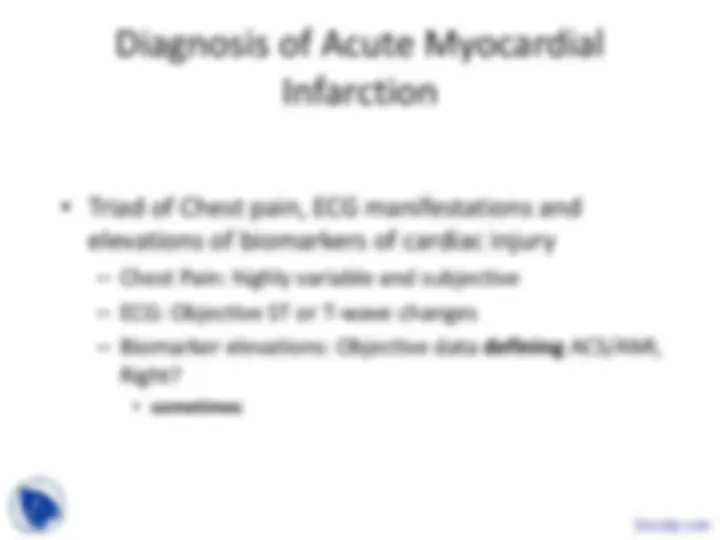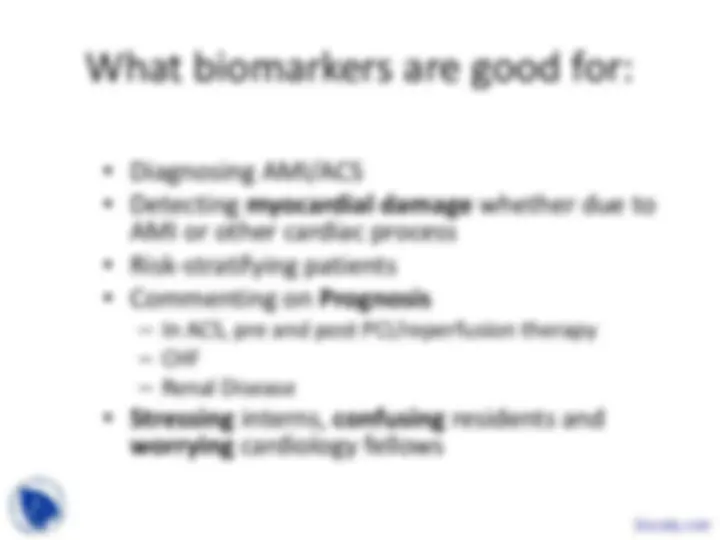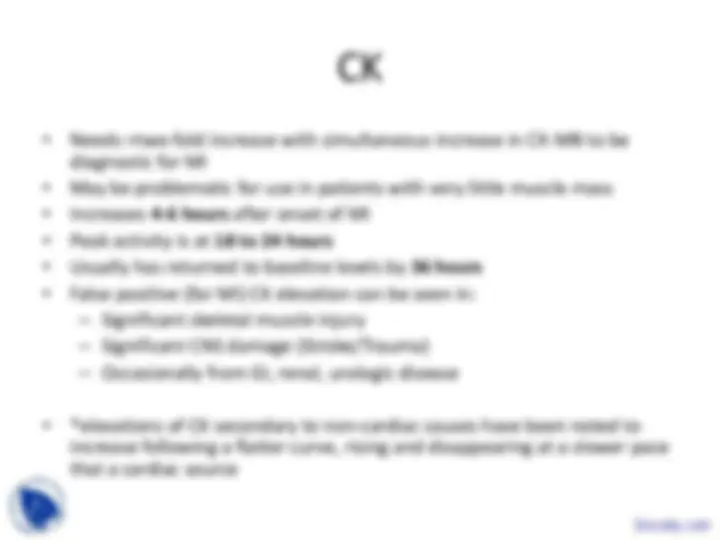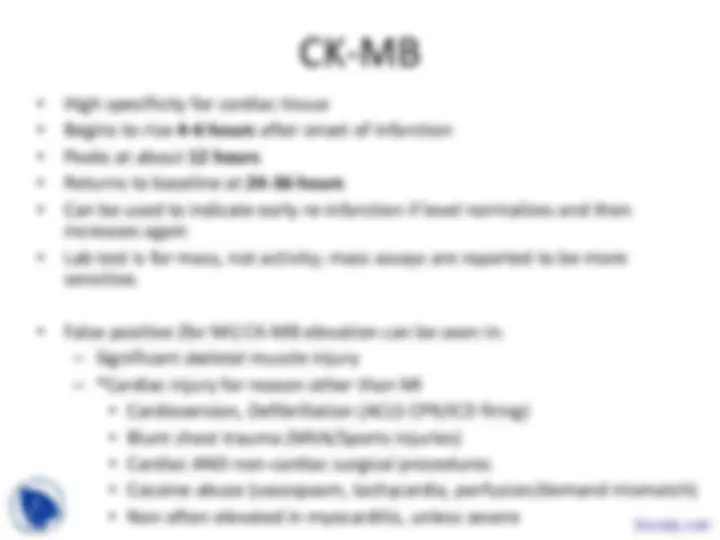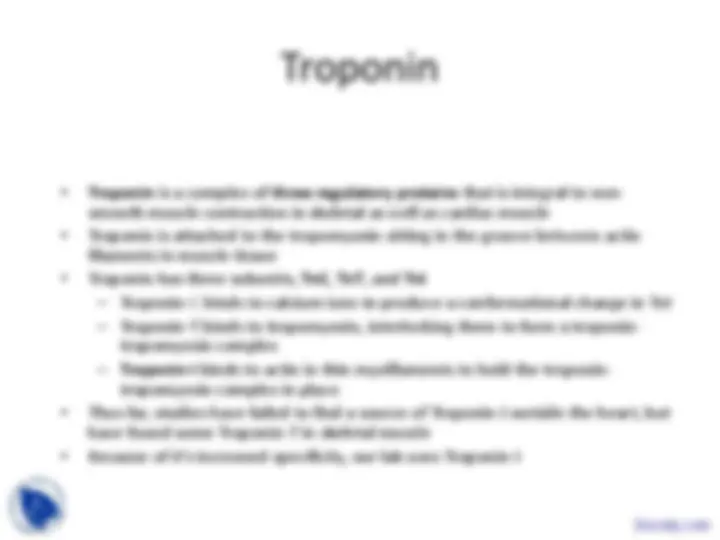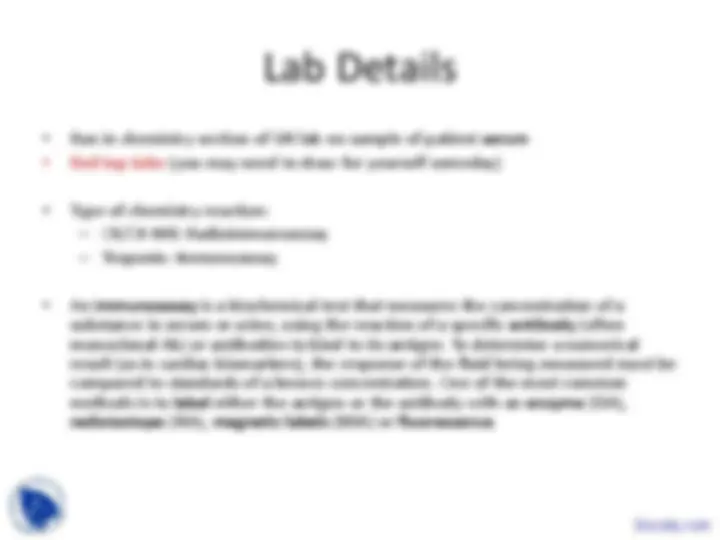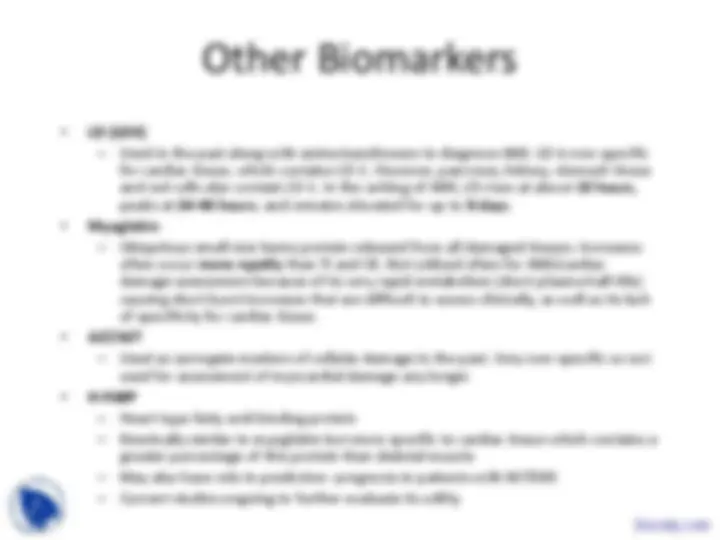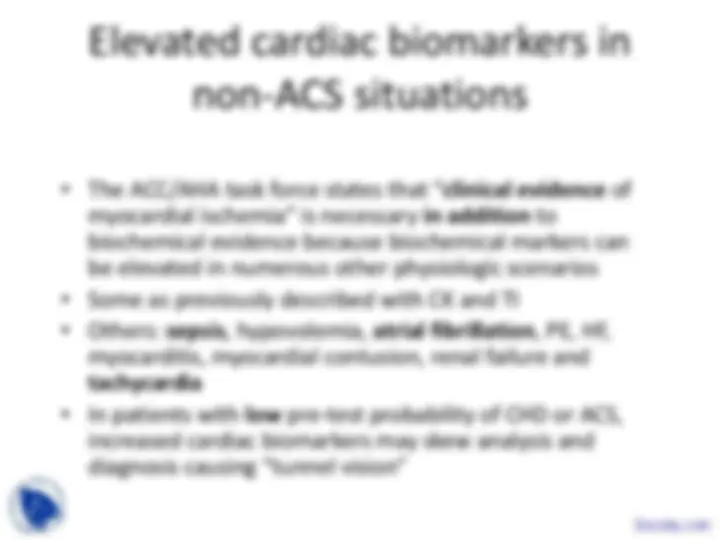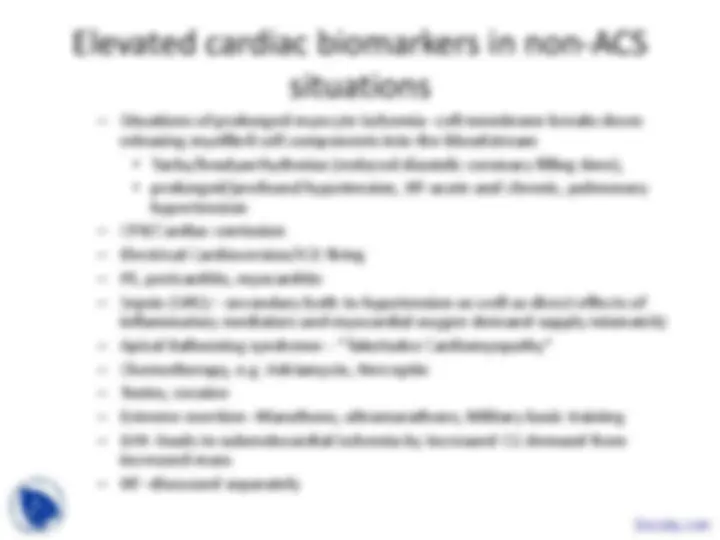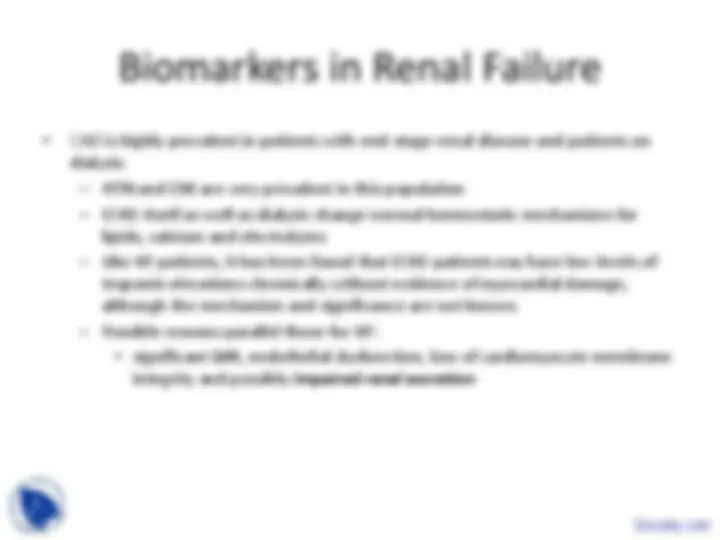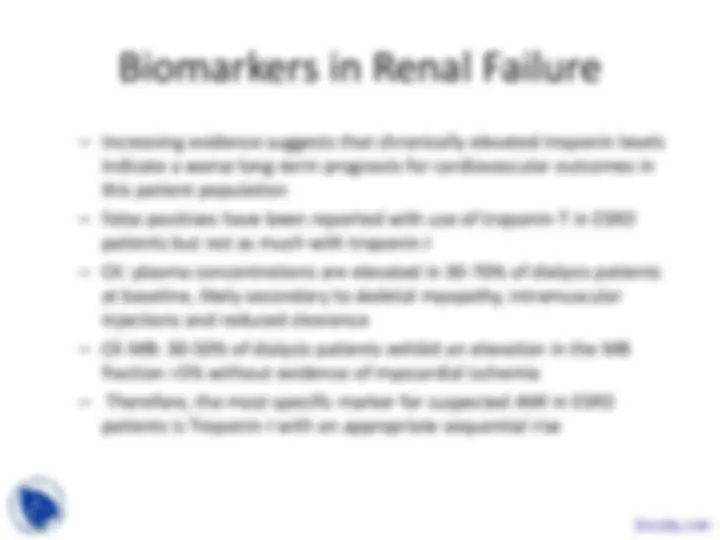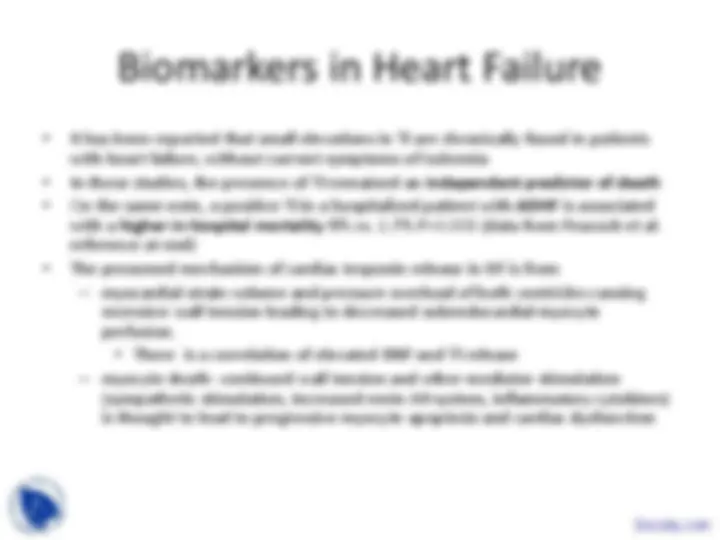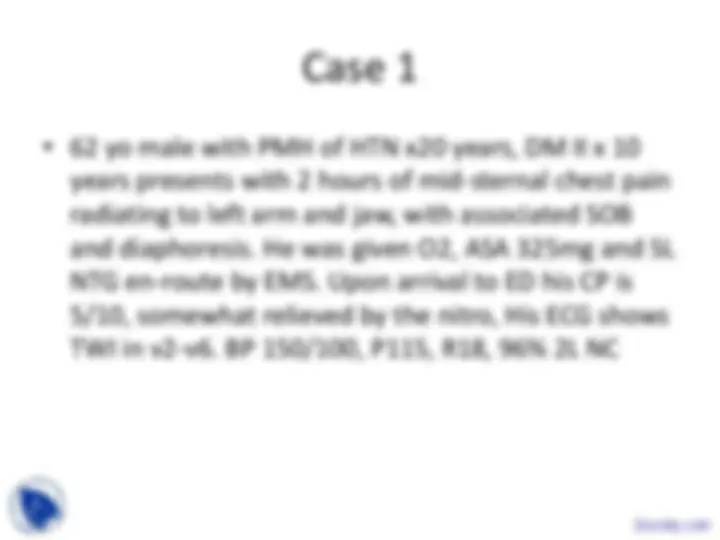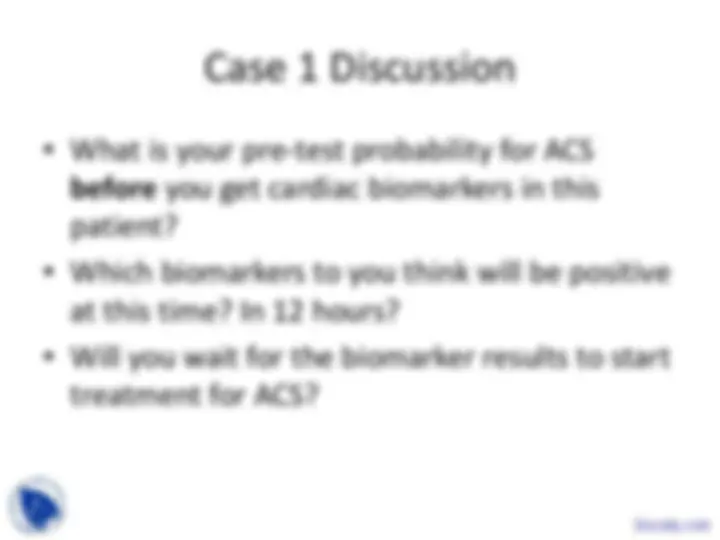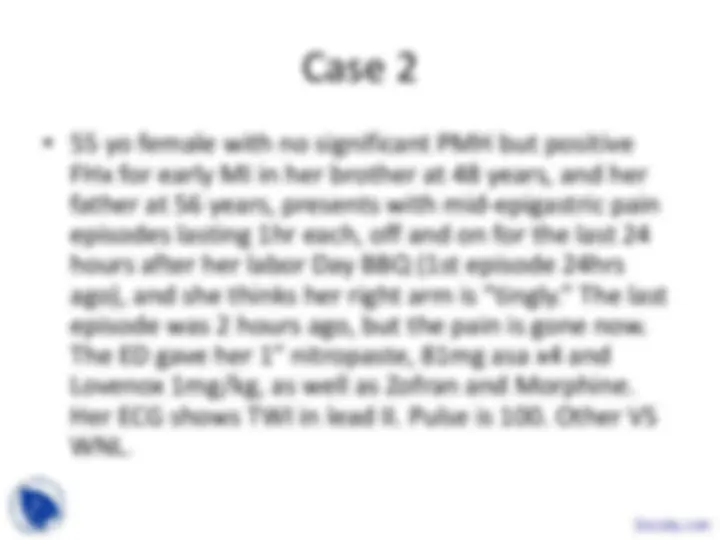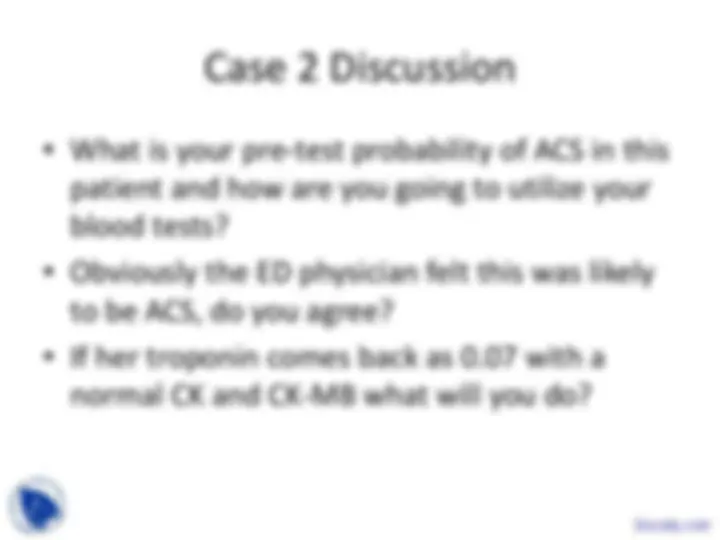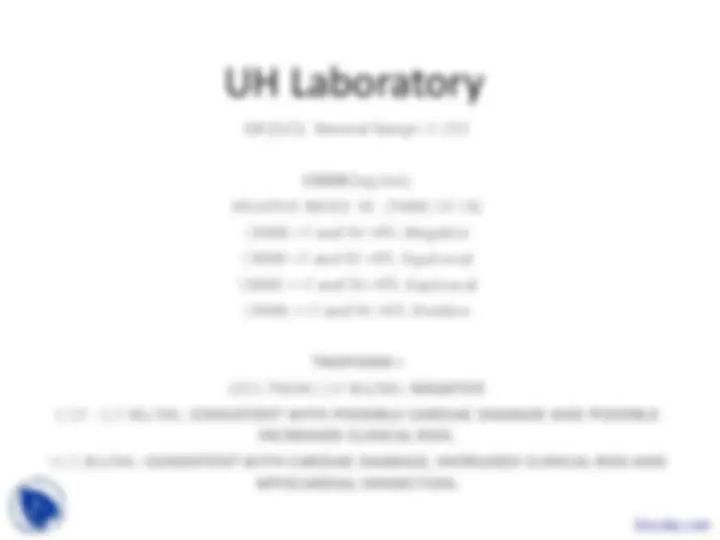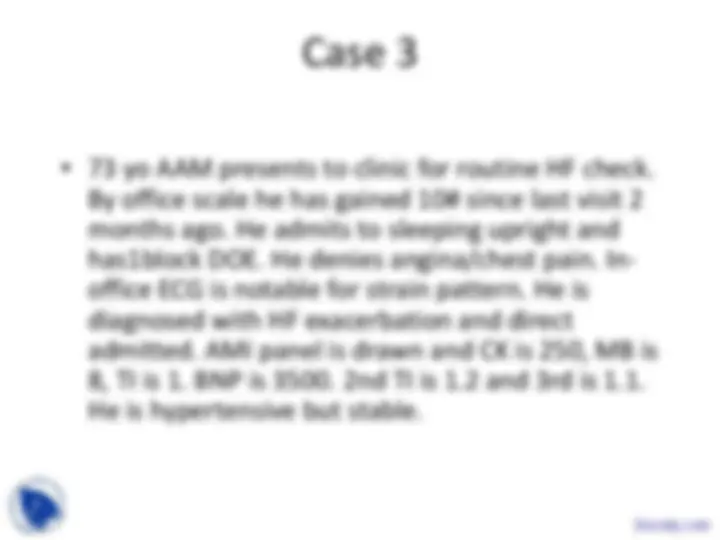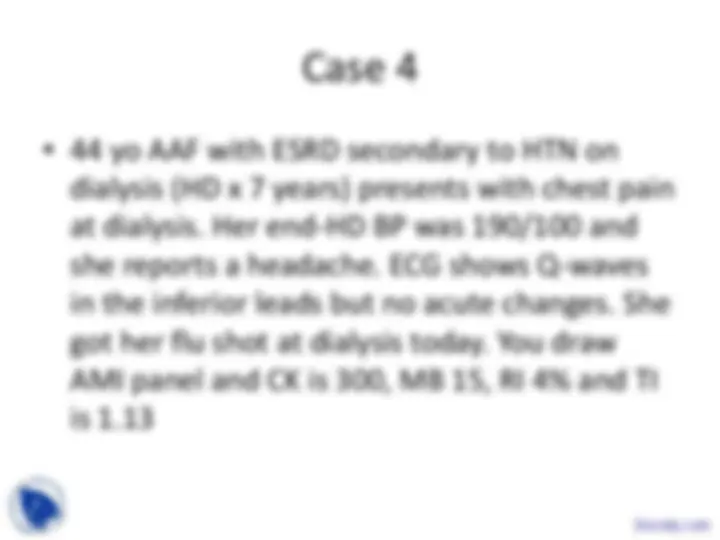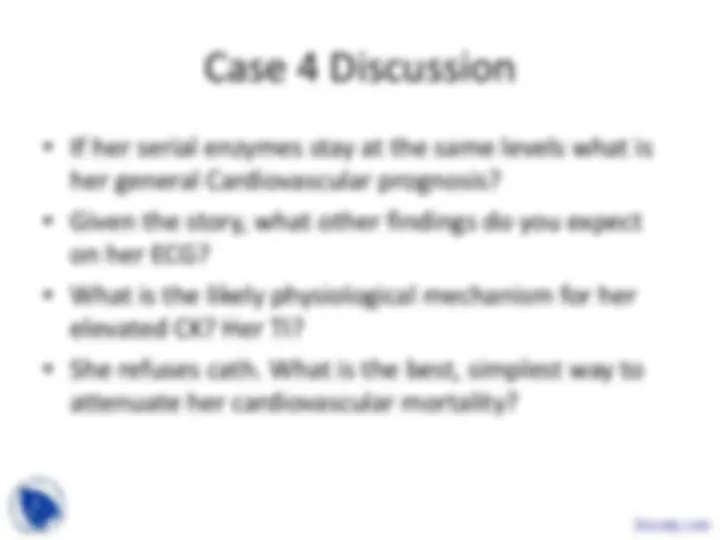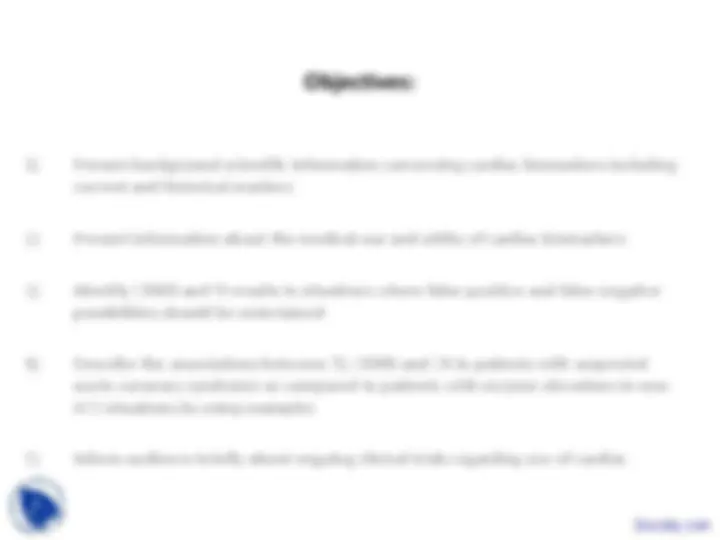Download Cardiac Biomarkers - Introduction to General Medicine - Lecture Slides and more Slides Medicine in PDF only on Docsity!
Cardiac Biomarkers:
Definitions, Use and Utility
Objectives
- Present background scientific information concerning cardiac biomarkers including
current and historical markers
Present information about the medical use and utility of cardiac biomarkers
Identify CKMB and TI results in situations where false-positive and false-negative
possibilities should be entertained
- Describe the associations between TI, CKMB and CK in patients with suspected
acute coronary syndrome as compared to patients with enzyme elevations in non- ACS situations by using examples
- Inform audience briefly about ongoing clinical trials regarding use of cardiac
Diagnosis of Acute Myocardial
Infarction
- Triad of Chest pain, ECG manifestations and
elevations of biomarkers of cardiac injury
- Chest Pain: highly variable and subjective
- ECG: Objective ST or T-wave changes
- Biomarker elevations: Objective data defining ACS/AMI,
Right?
What biomarkers are good for:
• Diagnosing AMI/ACS
• Detecting myocardial damage whether due to
AMI or other cardiac process
• Risk-stratifying patients
• Commenting on Prognosis
- In ACS, pre and post PCI/reperfusion therapy
- CHF
- Renal Disease
• Stressing interns, confusing residents and
worrying cardiology fellows
Creatine Kinase
Creatine kinase (CK/CPK) is an enzyme expressed in a number of tissues. Function: it catalyses the conversion of creatine to phosphocreatine degrading ATP to ADP (In cardiac as well as other tissues, phosphocreatine serves as an energy reservoir for the rapid regeneration of ATP)
The CK enzyme consists of two subunits, B (brain type) or M (muscle type), Making three different isoenzymes: CK-MM, CK-BB and CK-MB
- CK-BB occurs mainly in tissues, rarely of any significance in the bloodstream
- Skeletal muscle expresses CK-MM (98%) and low levels of CK-MB (1%)
- Sensitive lab tests can pick up these low levels of CK-MB from skeletal muscle
- The myocardium has CK-MM at 70% and CK-MB at ~30%
- CK therefore, lacks specificity for cardiac damage and needs to be augmented with the MB fraction and Relative Index (RI) to indicate true cardiac damage
CK
- Needs >two-fold increase with simultaneous increase in CK-MB to be
diagnostic for MI
- May be problematic for use in patients with very little muscle mass
- Increases 4-6 hours after onset of MI
- Peak activity is at 18 to 24 hours
- Usually has returned to baseline levels by 36 hours
- False positive (for MI) CK elevation can be seen in:
- Significant skeletal muscle injury
- Significant CNS damage (Stroke/Trauma)
- Occasionally from GI, renal, urologic disease
- *elevations of CK secondary to non-cardiac causes have been noted to
increase following a flatter curve, rising and disappearing at a slower pace
that a cardiac source
Troponin
- Troponin is a complex of three regulatory proteins that is integral to non- smooth muscle contraction in skeletal as well as cardiac muscle
- Troponin is attached to the tropomyosin sitting in the groove between actin filaments in muscle tissue
- Troponin has three subunits, TnC , TnT , and TnI
- Troponin-C binds to calcium ions to produce a conformational change in TnI
- Troponin-T binds to tropomyosin, interlocking them to form a troponin- tropomyosin complex
- Troponin-I binds to actin in thin myofilaments to hold the troponin- tropomyosin complex in place
- Thus far, studies have failed to find a source of Troponin-I outside the heart, but have found some Troponin-T in skeletal muscle
- Because of it’s increased specificity, our lab uses Troponin-I
More about Troponin
• Laboratory range definition:
– Cutoff is set at 99th percentile of a normal
reference population, variation of less than 10%
– Since troponin levels are virtually undetectable in
normal subjects, this 99th percentile corresponds
to <0.
– -heparin in sample can result in lowered values
Troponin Influence on Prognosis
• Since normal people have virtually nil levels of
troponin in serum, it is thought that detectable levels
indicate chronic disease even if not acute myocardial
damage
• Degree of elevation of Troponin value can give
prognostic information
- Some data suggest that the 72-96 hour peak TI value
correlates with infarct size. This is not necessarily true with
other biomarkers
Lab Details
- Run in chemistry section of UH lab on sample of patient serum
- Red top tube (you may need to draw for yourself someday)
- Type of chemistry reaction:
- CK/CK-MB: Radioimmunoassay
- Troponin: Immunoassay
- An immunoassay is a biochemical test that measures the concentration of a substance in serum or urine, using the reaction of a specific antibody (often monoclonal Ab) or antibodies to bind to its antigen. To determine a numerical result (as in cardiac biomarkers), the response of the fluid being measured must be compared to standards of a known concentration. One of the most common methods is to label either the antigen or the antibody with an enzyme (EIA), radioisotope (RIA), magnetic labels (MIA) or fluorescence.
UH Laboratory
CK ( U/L) Normal Range: 0-
CKMB ( ng/mL) RELATIVE INDEX- RI (%MB OF CK) CKMB <7 and RI <4% :Negative CKMB <7 and RI >4% :Equivocal CKMB >=7 and RI <4% :Equivocal CKMB >=7 and RI >4% :Positive
TROPONIN I LESS THAN 0.07 NG/ML: NEGATIVE 0.07 - 0.5 NG/ML: CONSISTENT WITH POSSIBLE CARDIAC DAMAGE AND POSSIBLE INCREASED CLINICAL RISK.
0.5 NG/ML: CONSISTENT WITH CARDIAC DAMAGE, INCREASED CLINICAL RISK AND MYOCARDIAL INFARCTION.
Timing Summary
TEST ONSET PEAK DURATION
CK/CK-MB 3-12 hours 18-24 hours 36-48 hours
Troponins 3-12 hours 18-24 hours Up to 10 days
Myoglobin 1-4 hours 6-7 hours 24 hours
LDH 6-12 hours 24-48 hours 6-8 days
Elevated cardiac biomarkers in non-ACS
situations
- Situations of prolonged myocyte ischemia--cell membrane breaks down releasing myofibril cell components into the bloodstream - Tachy/bradyarrhythmias (reduced diastolic coronary filling time), - prolonged/profound hypotension, HF-acute and chronic, pulmonary hypertension
- CPR/Cardiac contusion
- Electrical Cardioversion/ICD firing
- PE, pericarditis, myocarditis
- Sepsis (SIRS)-- secondary both to hypotension as well as direct effects of inflammatory mediators and myocardial oxygen demand-supply mismatch)
- Apical Ballooning syndrome-- “Takotsubo Cardiomyopathy”
- Chemotherapy, e.g. Adriamycin, Herceptin
- Toxins, cocaine
- Extreme exertion--Marathons, ultramarathons, Military basic training
- LVH--leads to subendocardial ischemia by increased O2 demand from increased mass
- HF--discussed separately
Biomarkers in Renal Failure
- CAD is highly prevalent in patients with end-stage renal disease and patients on
dialysis.
- HTN and DM are very prevalent in this population
- ESRD itself as well as dialysis change normal homeostatic mechanisms for lipids, calcium and electrolytes
- Like HF patients, it has been found that ESRD patients nay have low levels of troponin elevations chronically without evidence of myocardial damage, although the mechanism and significance are not known.
- Possible reasons parallel those for HF:
- significant LVH , endothelial dysfunction, loss of cardiomyocyte membrane integrity and possibly impaired renal excretion


